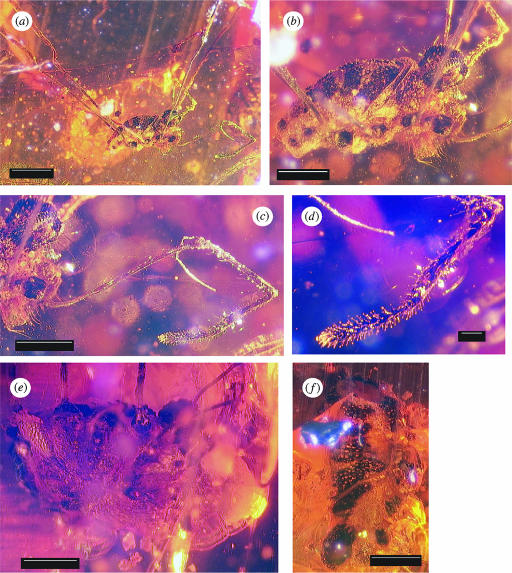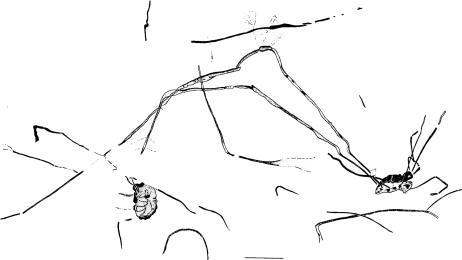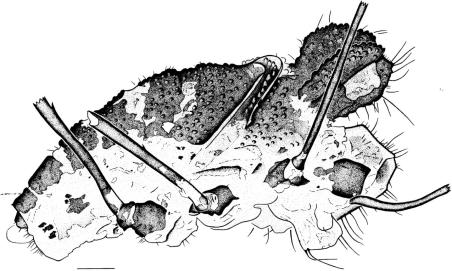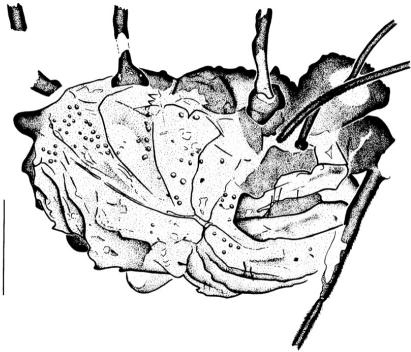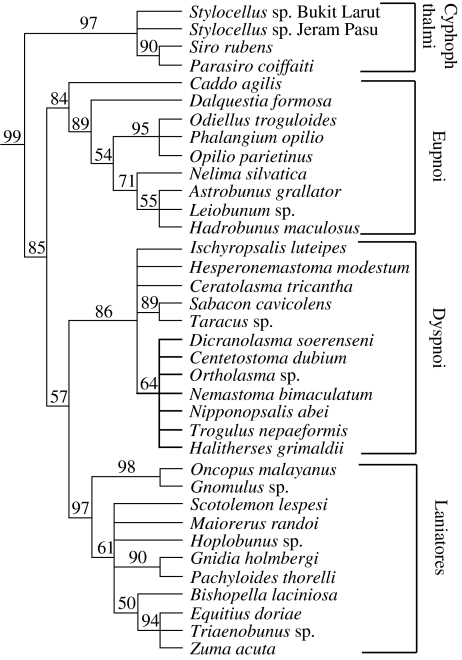Abstract
Two inclusions in a piece of Upper Cretaceous (Albian) Burmese amber from Myanmar are described as a harvestman (Arachnida: Opiliones), Halitherses grimaldii new genus and species. The first Mesozoic harvestman to be named can be referred to the suborder Dyspnoi for the following reasons: prosoma divided into two regions, the posterior formed by the fusion of the meso- and metapeltidium; palp lacking a terminal claw, with clavate setae, and tarsus considerably shorter than the tibia. The bilobed, anteriorly projecting ocular tubercle is reminiscent of that of ortholasmatine nemastomatids. The status of other Mesozoic fossils referred to Opiliones is briefly reviewed.
Keywords: Myanmar, systematics, Nemastomatidae, Ortholasmatinae
1. Introduction
Fossil harvestmen go back some 400 million years to the Early Devonian (Dunlop et al. 2003). Most of these very rare Palaeozoic forms closely resemble extant members of the suborder Eupnoi. However, at least two Pennsylvanian species (Thevenin 1901; Dunlop 2004) are reminiscent of troguloids and appear to be members of the Dyspnoi. The entire Mesozoic (248–265 Myr) has so far yielded only one reliable harvestman fossil (Jell & Duncan 1986; see also §5). These authors felt that their Australian specimen was too poorly preserved to merit naming it, or discussing its affinities further. The most abundant and diverse fossil harvestman record comes from Tertiary shales and ambers (e.g. Cokendolpher & Poinar 1998; Starega 2002; Dunlop & Giribet 2003). Baltic, Bitterfeld and Dominican amber have all yielded harvestmen, and between them, all four major clades (Cyphophthalmi, Eupnoi, Dyspnoi and Laniatores) have now been recorded. These Tertiary inclusions have mostly been assigned to living genera.
Here, we describe the first fossil harvestman from Cretaceous Burmese amber, Myanmar. Significantly, this is also the first Mesozoic harvestman to be named. Our fossils can be referred to Dyspnoi based on the fusion of the prosomal meso- and metapeltidium into a single fold, lack of a palpal claw, relative length of the palpal tarsus and tibia, and presence of clavate setae in the palp. Additionally, the status of other putative Mesozoic harvestmen from Germany, Lebanon and France is reviewed. All should probably be excluded from Opiliones.
2. Methods
The two new fossils (figures 1–5) are probably conspecific inclusions—both with large eyes and a similar pattern of granular body ornament—in a single piece of Burmese amber deposited at the American Museum of Natural History (AMNH Bu-1583). We refer to the better-preserved example in lateral view (Bu-1583a) as the holotype and the less well-preserved example in ventral view (Bu-1583b) as the paratype. The amber piece is part of a large collection made in 2000 by the Leeward Capitol Corporation and comes from Tanai Village on the Ledo road, 105 km northwest of Myitkyna, Katchina, Myanmar (formerly Burma). Further details of this extensive and important Leeward collection can be found in Grimaldi et al. (2002). The material was photographed using a JVC KY-F70B digital camera mounted on a Leica MZ 12.5 stereomicroscope. A series of images (from 4 to 10) were taken at different focal planes and assembled with the dedicated software package Auto-Montage Pro v. 5.00.0271 by Syncroscopy. The fossils were drawn with the aid of a camera lucida attachment and compared with collections of Recent harvestmen in the Harvard and Berlin collections, as well as with the literature.
Figure 1.
Halitherses grimaldii new genus and species. The first fossil harvestman from Burmese amber, Lower Cretaceous (amber). (a) Lateral aspect of holotype Bu-1583a; scale bar, 1 mm. (b) Detailed lateral view of holotype Bu-1583a; scale bar, 0.5 mm. (c) Front end of lateral view of holotype Bu-1583a showing extended right pedipalp; scale bar, 0.5 mm. (d) Detail of Bu-1583a tarsus and tibia of right pedipalp showing the clavete setae; scale bar, 0.1 mm. (e) Ventrolateral view of paratype Bu-1583b; scale bar, 0.5 mm. (f) Posterodorsal view of paratype Bu-1583b; scale bar, 0.5 mm.
Figure 2.
Camera lucida drawing of the specimens shown in figure 1. Scale bar, 2 mm.
Figure 3.
Detail of the body of the holotype Bu-1583a in lateral view. Scale bar, 0.2 mm.
Figure 4.
(a) Detail of the right pedipalp of the holotype and (b) the end of a disarticulated walking leg. Scale bar, 0.2 mm.
Figure 5.
Detail of the paratype Bu-1583b in ventral view. Scale bar, 0.5 mm.
(a) Burmese amber
Burmese amber, sometimes called Myanmar amber or ‘Burmite’, originates from the northern region of Myanmar and has long been mined for use in jewellery. Further details about the history, origins and dating of this amber can be found in Zherikhin & Ross (2000), Grimaldi et al. (2002) and Ross & York (2004); the latter is an introduction to a series of further papers in the same journal describing new inclusions. Grimaldi et al. (2002) dated Burmese amber to Upper Cretaceous (?Cenomanian–Turonian), approximately 88–98 Myr ago. Subsequently, Cruickshank & Ko (2003) suggested a slightly older Albian age (ca. 99–112 Myr), with deposition in a near-shore tidal channel environment. Ross & York (2004) also accepted this Lower Cretaceous (Albian) date, which we adopt here. Amber is notoriously difficult to date precisely, but David Grimaldi (personal communication) suggested that a date of nearly 100 Myr ago seems reasonable. In any case, the amber occurs as reworked material in younger (Tertiary) sediments. The significance of the Burmese amber is first that it is one of the few unequivocally Cretaceous ambers, which thus predates the Cretaceous–Tertiary (K–T) mass extinction. It enables investigations into whether terrestrial arthropod faunas were affected by the K–T event (e.g. Penney et al. (2003); who argued that spiders were mostly unaffected at the family level). Second, it is the only major amber deposit known thus far from Southeast Asia, and this, coupled with its low palaeolatitude (ca. 12°N in Cretaceous times; Grimaldi et al. 2002), makes it valuable for historical studies of biogeography.
(b) Other arachnid inclusions
Spiders (an archaeid and a pisaurid) from Burmese amber have recently been described (Penney 2003, 2004a). Scorpions have been described by Lourenço (2002) and Santiago-Blay et al. (2004). In addition, the Burmese fauna also includes diverse mites and pseudoscorpions (Grimaldi et al. 2002), all of which await formal description. The present material was discovered after the 2002 publication and was thus not listed in that paper. Grimaldi et al. (2002) also found good evidence that Burmese amber sampled a tropical forest environment and, given its tropical nature, they speculated that in time this may prove to be one of the most species-rich amber deposits yet recorded.
3. Preservation
Two harvestman fossils are preserved within a subrectangular block of reddish amber, which also includes two nematode worms and a fly (all unidentified). The amber has been polished to provide a clear lateral view of the right side of the holotype (figures 1a–d, 3, 4). Viewed from the other side, the body of this specimen lies deeper in the matrix and is partly obscured by an internal crack. The paratype (figures 1e, 5) is less well preserved owing to the angle of inclusion in the amber matrix. It reveals the coxae of the walking legs and the genital opeculum. The chelicerae are also observed in resting position, but the dentition of the chela is not observed. By tilting the specimen, a heavily ornamented and pigmented large sclerite is seen posterior to the genital segment. The small size of the opisthosomal region suggests that the paratype is a male. From the other side the dorsal and rear end of the specimen is visible. As in the holotype, one can discern the large eye tubercle and the pustulate opisthosomal tergites, but the anal region has been cut and therefore lacks all important tergites and sternites, as well as the anal plate (figure 1f). The legs in the paratype are largely missing. The matrix also includes a number of disarticulated limbs or limb fragments which probably also belonged to at least one of the harvestmen. Right leg 1 of the holotype is missing from the body and may be one of the detached limbs in the matrix. The polishing process has curtailed right legs 2 and 3 in the holotype, but the femora are still preserved. Extant harvestmen lose their legs quite commonly and it is easy to imagine some limbs breaking off from animals struggling to free themselves from sticky resin. Generally, there is some suggestion of dehydration of the specimens and a number of the long limb articles have become slightly twisted or are shrivelled in appearance.
4. Systematic palaeontology
Suborder Dyspnoi Hansen & Sørensen, 1904
Superfamily Troguloidea Sundevall, 1833
Genus Halitherses new genus
Etymology. In Greek mythology, Halithersês was an Ithacan prophet who warned the suitors of Odysseus's wife Penelope to ‘be wise in time, and put a stop to this wickedness before he comes.’ The name derives from the large eyes that appear to look at us from the past, like an oracle.
Diagnosis. Dyspnoid with heavily ornamented carapace, dominated by massive, bilobed eye tubercle. Each lobe suboval and directed forward, overhanging anterior margin of prosoma. Pustulate cuticle forms impression of a heavy ‘eyelid’ above eye lens. Eye lobes bear numerous fine setae. Legs extremely long and slender, up to 13 times the length of the body.
Halitherses grimaldii new species (figures 1--5).
Type and only material. AMNH Bu-1583a/b. Holotype (a, in lateral view) and paratype (b, in ventral view). From Burmese amber, Myanmar. Katchin: Tanai Village (on Ledo road 105 km northwest of Myitkyna). Coll. Leeward Capitol Corporation, 2000. Lower Cretaceous (Albian).
Etymology. For David Grimialdi (AMNH, New York) who kindly made the material available for study and in recognition of his extensive work on Burmese amber.
Diagnosis. As for the genus.
Description. Prosoma (figures 1b, 3) divided into large propeltidium and a fused meso- and metapeltidium by discrete transversal furrow. This region is defined by a clear, saddle-like band, offset from the opisthosoma. Fused meso–metapeltidium emerges from underneath propeltidium and bears a distinct row of dark, pillar-like tubercles. Presence of sensory cones on the metapeltidium equivocal. Propeltidium dominated by massive, bilobed eye tubercle; without a trident. Each eye lobe projecting anteriorly, such that it overhangs the anterior margin of prosoma by some distance. Eyes unusually large, approaching the condition seen in the family Caddidae (although in Halitherses the eyes sit firmly on the carapace). Carapace cuticle has a distinctly pustulate or granular ornament which continues onto cuticle around eye lens. Above eye lens, pustulate cuticle forms a heavy eyelid. Eye lobes also bear numerous fine setae, most of which project forwards and some of which are quite long. Eye tubercle, posterior part of propeltidium, and fused meso- and metapeltidium with a black pigment at both sides following each eye tubercle lobule. Pigmentation pattern continues posteriorly through opisthosoma. Ventral prosomal morphology fairly typical for harvestmen with triangular leg coxae arranged around gap-like stomothaeca anteriorly and forward-projecting genital operculum posteriorly. Coxae also express pustulate ornament similar to dorsal surface, but here is less pronounced and dense. Any marginal row of interlocking coxal tubercules equivocal. Coxae occupy approximately half total length in ventral view and surround triangular genital operculum which projects forwards between leg bases. Repugnatorial glands and supracheliceral lamellae equivocal.
Chelicerae are of moderate size compared with those of other harvestmen. Chelicera of holotype mostly folded underneath body, but with distinct and prominent fringe of hairs that pass through a ‘film’ in the matrix. Distal end of chelicerae equivocal. Chelicerae of paratype rather narrow (?dehydrated). Chela visible—but not its dentition—resembling that of certain Dyspnoi genera. Pedipalps smooth, elongate, gracile and pediform. Articles decrease in length going from femora to tarsi. Measurements of holotype palpal articles from proximal to distal: 0.42/1.05/0.87/0.72/0.44 mm. Tibia and tarsus become increasingly wide and, in contrast to proximal articles, bear numerous short setae. Under high magnification (figure 1c) these setae show rounded, globular distal tips, resembling clavate setae. Tarsus shorter than tibia. Conspicuous palpal claw absent. Legs long and extremely slender (again due to dehydration?) with short, quadrate trochanters. Leg 4 on both sides almost complete and extremely long, at least 13 times the length of the body (distal tip is missing). Legs generally lack ornament, except for short thorns which occur sporadically along leg, mostly on femora. Distal regions of leg preserved in at least three of the disarticulated examples. Leg tips divided into many (ca. 25) tarsomeres, becoming shorter distally and all bearing dense coating of fine setae. Legs end in a single, curved tarsal claw, lacking ornamentation.
Opisthosoma curves downwards posteriorly in lateral view, such that the whole structure sits at an angle like a shield against the prosoma. Dorsal surface of body with pustulate ornament and a specific pattern of pigmentation. Pustules arranged in regular rows on the more anterior tergites, becoming less frequent and fading away on posterior tergites. Tergites themselves indistinct, but revealed by darker bands with slight folds of paler cuticle in between; at least anteriorly. Six tergites can be resolved, essentially fused together to form a scutum, beyond which there appears to be a disjunct region with slight tagmosis and one further segment around presumptive anal region. Fault in the matrix implies a second anal segment, but careful examination reveals no cuticle here (figure 1b). Lateral margins of tergites obscured in lateral view of holotype and seem to merge into paler area where details cannot be resolved. Posterior margin of opisthosoma with a fringe of setae. Sternal opisthosomal region equivocal in holotype and rather poorly resolved in paratype. Large genital operculum present in paratype and behind it a large sternite, heavily sclerotized and ornamented. Postero-lateral margins of opisthosoma appear to form at least two pairs of bluntly rounded spines. Posterior end of paratype opisthosoma with hints of ring-like anal region, probably corresponding to offset segment visible in holotype.
Remarks. The most important structure to determine the affinities of this fossil is the pedipalp. The absence of a palpal claw (it may be highly reduced to a nubbin) positions this species within Dyspnoi, while the presence of clavate palpal setae restricts its affinities to the superfamily Troguloidea (Shear & Gruber 1983; Shear 1986; Giribet et al. 2002). The relative length of the palpal tarsus/tibia is also characteristic of most Dyspnoi, where the tarsus is considerably shorter than the tibia. The presence of two main prosomal regions concords with the fusion of the meso- and metapeltidium in most Dyspnoi (whose prosoma and opisthosoma do not fuse). The fused meso–metapeltidium is heavily ornamented with dark nodule-like granules, but in the central region three pillar-like structures, almost translucent, are visible, and they could be metapeltidial sensory cones, mostly present in ischyropsalidoid species and in Caddo (Shear 1986; Shultz 1998; Giribet et al. 2002). Another character shared by most Dyspnoi is the presence of a cheliceral gland situated in the proximal joint of the basal cheliceral article in the males (Martens & Schawaller 1977). Although this character cannot be observed in the specimens described, it is interesting to note a special type of secretion forming a sheet that surrounds the chelicerae, being somehow similar to the secretions observed around secretory organs in the amber-preserved cyphophthalmid Siro platypedibus (Dunlop & Giribet 2003). The small opisthosoma would be characteristic for a male, so it seems possible that the secretion around the chelicerae originates from a cheliceral gland.
The exact position of this material within Dyspnoi is more contentious. When the new fossil is included into an updated version of the morphological dataset of Giribet et al. (2002) (see also the Electronic Appendix), parsimony analysis using TNT (Goloboff et al. 2003) results in 138 trees of 495 steps. The strict consensus of all the most parsimonious trees with jackknife support values is presented in figure 6. The inclusion of our new species within Dyspnoi (jackknife support value of 86%) and Troguloidea (jackknife support value of 64%) is supported by the morphological analysis. A character that supports a troguloidean affinity is the presence of clavate palpal setae. The forward-projecting eye tubercle, the heavy cuticular ornamentation and the fused meso- and metapeltidia resemble those of the ortholasmatine nemastomatids. However, the type of scutum, formed of six opisthosomal segments, differs from these groups that tend to present a scutum parvum that incorporate only five opisthosomal segments. Another argument for relating the amber fossils to Ortholasmatinae is their biogeographical distribution, restricted to western North America, Japan and Thailand (Shear & Gruber 1983; Suzuki 1963; Schwendinger & Gruber 1992). Of special interest is the Thai species Dendrolasma angka Schwendinger & Gruber, 1992, which inhabits tropical cloud forests from Northern Thailand; a habitat that could be similar to the one captured in the Burmese amber.
Figure 6.
Strict consensus cladogram illustrating the phylogenetic position of Halitherses grimaldii new genus and species, derived from a modified version of the character matrix of Giribet et al. (2002). Outgroup relationships not shown. Numbers above branches indicate jackknife proportions. The search consisted of 100 Wagner addition replicates followed by tree bisection and reconnection branch swapping. A total of 138 trees of 495 steps were found.
5. Mesozoic fossils dubiously assigned to opiliones
(a) Solnhofen, Germany
The Jurassic Hasseltides primigenius (Weyenbergh 1869) from Solnhofen in Germany was originally believed to be a fossil spider. It was subsequently reinterpreted as an opilionid (van Hasselt in Weyenbergh 1874), but was eventually correctly recognized as a crinoid (Echinodermata; van Regteren Altena in Petrunkevitch 1955). A more common, long-legged Solnhofen fossil, Phalangites priscus Münster 1836, has been variously interpreted as either a pycnogonid (sea spider), a spider or a harvestman. Detailed study (e.g. Polz 1975) has confirmed earlier suspicions that these fossils (and a number of similar Solnhofen genera) are the moulted exoskeletons of larval phyllosome crustaceans.
(b) Sahel-Alma, Lebanon
The unnamed, long-legged arthropods described by Roger (1946, pp. 64–65) as harvestmen from Upper Cretaceous (Santonian) limestones in Sahel-Alma, Lebanon merit restudy. As Roger noted, they come from a fully marine setting, associated with animals like decapod crustaceans and cephalopod molluscs; the latter an exclusively marine group. This is an extremely unlikely place to find Opiliones; for example, Crawford's (1992) comments on a similar case involving a putative fossil harvestman from the Oligocene of Romania (Ciobanu 1977). Roger (1946) suggested that the Lebanese ‘opilionids’ had become washed in from a terrestrial environment, but this seems far-fetched given (i) the fragility of harvestmen legs and the fact that they remain articulated in the fossils and (ii) the absence of other terrestrial elements such as an extensive insect fauna which would normally massively outnumber a handful of arachnids. Conceivably, some of these fossils could be crustaceans or even pycnogonids (both alternatives being mentioned, but ultimately rejected by Roger). However, Penney (2004b; figure 4) figured at least one Lebanese specimen—customarily on display in Paris and labelled as an opilionid—which does look convincingly like a spider.
(c) Paris Basin, France
Finally, a supposed harvestman figured by Schlüter (1978, pp. 48–50) from Cretaceous (Cenomanian) amber of the Paris and Aquitaine Basins, northwest France, is almost certainly a mite. The original drawing (his fig. 17) is poor, but implies a smooth dorsal body surface. Unlike harvestmen, it has a distinctly demarcated anterior region bearing chelicerae, flanked by tiny, paddle-shaped pedipalps. This offset region is clearly a gnathostoma, an autapomorphy of mites (Acari), never seen in harvestmen. In fact, the pedipalp shape is wholly consistent with the capitulum of a tick (Acari: Ixodida). Efforts to recover the original material at its cited repository in the Freie-Universität Berlin proved unsuccessful.
The present Burmese amber material and the Australian harvestman figured by Jell & Duncan (1986) appear to be the only unequivocal Mesozoic records of Opiliones.
Acknowledgments
We thank David Grimaldi (AMNH, New York) for making this specimen available for study and for helpful comments on the locality, and David Penney (Manchester) and two anonymous reviewers for useful comments. Ward Wheeler and Zoe Wheeler are thanked for discussions on Greek mythology that resulted in the generic name assigned to the species.
Supplementary Material
References
- Ciobanu M. Academiei Republicii Socialiste Romania; Bucarest: 1977. The fossil fauna of Oligocene in Piaţra Neamt. [Google Scholar]
- Cokendolpher J.C, Poinar G.O., Jr A new fossil harvestman from Dominican Republic amber (Opiliones, Samoidae, Hummelinckiolus) J. Arachnol. 1998;26:9–13. [Google Scholar]
- Crawford R.L. Catalogue of the genera and type species of the harvestman superfamily Phalangioidea (Arachnida) Burke Mus. Contrib. Anthropol. Nat. Hist. 1992;8:1–60. [Google Scholar]
- Cruickshank R.D, Ko K. Geology of an amber locality in the Hukawng Valley, northern Myanmar. J. Asian Earth Sci. 2003;21:441–455. [Google Scholar]
- Dunlop J.A, Giribet G. The first fossil cyphophthalmid (Arachnida: Opiliones) from Bitterfeld amber. J. Arachnol. 2003;31:371–378. [Google Scholar]
- Dunlop J.A, Anderson L.I, Kerp H, Hass H. Preserved organs of Devonian harvestmen. Nature. 2003;425:916. doi: 10.1038/425916a. [DOI] [PubMed] [Google Scholar]
- Dunlop, J. A. 2004 A spiny harvestman (Arachnida: Opilones) from the Upper Carboniferous of Missouri, USA. In European Arachnology 2003. Arthropoda Selecta (ed. D. V. Logunov & D. Penney), Special Issue No. 1, pp. 67–74. Moscow: KKM Scientific Press Ltd.
- Giribet G, Edgecombe G.D, Wheeler W.C, Babbitt C. Phylogeny and systematic position of Opiliones: a combined analysis of chelicerate relationships using morphological and molecular data. Cladistics. 2002;18:5–70. [PubMed] [Google Scholar]
- Goloboff P.A, Farris J.S, Nixon K. 2003. TNT: tree analysis using new technology, version 1.0. (Program and documentation available at http://www.zmuc.dk/public/phylogeny/TNT/) [Google Scholar]
- Grimaldi D, Engel M.S, Nascimbene P. Fossiliferous Cretaecous amber from Burma (Myanmar): its rediscovery, biotic diversity and paleontological significance. Am. Mus. Novit. 2002;3361:1–71. [Google Scholar]
- Jell P.A, Duncan P.M. Invertebrates, mainly insects, from the freshwater Lower Cretaceous Koonwarra fossil bed (Korumburra Group), South Gippsland, Victoria. Mem. Assoc. Australas. Palaeontol. 1986;3:111–205. [Google Scholar]
- Lourenço W.R. The first scorpion fossil from the Cretaceous amber of Myanmar (Burma). New implications for the phylogeny of Buthoidea. C. R. Palevol. 2002;2:97–101. [Google Scholar]
- Martens J, Schawaller W. Die Cheliceren-Drüsen der Weberknechte nach rastoptischen und lichtoptischen Befunden (Arachnida: Opiliones) Zoomorphologie. 1977;86:223–270. [Google Scholar]
- Münster Graf von. Mitteilungen, an Professor Bronn gerichtet. Neues Jahrbuch für Mineralogie, Geognosie, Geologie und Petrefaktenkunde. 1836;1836:580–583. [Google Scholar]
- Penney D. Afrarchaea grimaldii, a new species of Archaeidae (Araneae) in Cretaceous Burmese amber. J. Arachnol. 2003;31:122–130. [Google Scholar]
- Penney D. A new genus and species of Pisauridae (Araneae) in Cretaceous Burmese amber. J. Syst. Palaeontol. 2004a;2:141–145. [Google Scholar]
- Penney D. A palaeoarachnological trip to Paris. Newsl. Br. Arachnol. Soc. 2004b;101:13–14. [Google Scholar]
- Penney D, Wheather C.P, Selden P.A. Resistance of spiders to Cretaceous–Tertiary extinction events. Evolution. 2003;57:2599–2607. doi: 10.1111/j.0014-3820.2003.tb01502.x. [DOI] [PubMed] [Google Scholar]
- Petrunkevitch A.I. Arachnida. In: Moore R.C, editor. Treatise on invertebrate paleontology, part P, Arthropoda 2. Geological Society of America and University of Kansas Press; Kansas: 1955. pp. 42–162. [Google Scholar]
- Polz H. Zur Unterscheidung von Phyllosomen und deren Exuvien aus den Solnhofener Plattenkalken. Neues Jahrbuch für Geologie und Paläontologie, Monatshefte. 1975:40–50. [Google Scholar]
- Roger J. Résultats scientifiques de la mission C. Arambourg en Syrie et en Iran (1938–39). Les Invertébrés des Couches à Poissons du Crétacé supérieur du Liban—étude Palébiologique des gisements. Mém. Soc. Géol. France Paléontol. 1946;51:1–92. [Google Scholar]
- Ross A.J, York P.V. The Lower Cretaceous (Albian) arthropod fauna of Burmese Amber. Myanmar: forward. J. Syst. Palaeontol. 2004;2:95–100. [Google Scholar]
- Santiago-Blay J.A, Fet V, Soleglad M.E, Anderson S.R. A new genus and species of scorpions from Lower Cretaceous Burmese amber (Scorpiones: Chaerilidae) Rev. Iber. Aracnología. 2004;9:3–14. [Google Scholar]
- Schlüter T. Zur Systematik und Palökologie harzkonservierter Arthropoda eine Tapzönose aus dem Cenomanium von NW-Frankreich. Berliner Geowissenschaftliche Abhandlungen, Reihe A. 1978;9:1–150. [Google Scholar]
- Schwendinger P.J, Gruber J. A new Dendrolasma (Opiliones, Nemastomatidae) from Thailand. Bull. Br. Arachnol. Soc. 1992;9:57–60. [Google Scholar]
- Shear W.A. A cladistic analysis of the opilionid superfamily Ischyropsalidoidea, with descriptions of the new family Ceratolasmatidae, the new genus Acuclavella, and four new species. Am. Mus. Novit. 1986;2844:1–29. [Google Scholar]
- Shear W.A, Gruber J. The opilionid subfamily Ortholasmatinae (Opiliones, Troguloidea, Nemastomatidae) Am. Mus. Novit. 1983;2757:1–65. [Google Scholar]
- Shultz J.W. Phylogeny of Opiliones (Arachnida): an assessment of the ‘Cyphopalpatores’ concept. J. Arachnol. 1998;26:257–272. [Google Scholar]
- Starega W. Baltic amber harvestmen (Opiliones) from Polish collections. Ann. Zool. 2002;52:601–604. [Google Scholar]
- Suzuki S. Cladolasma parvula gen. et sp. n. (Trogulidae: Opiliones) from Japan. Annotationes Zoologicae Japonicae. 1963;36:40–44. [Google Scholar]
- Thevenin A. Sur la découverte d'arachnides dans le terrain houiller de Commentry. Bull. Soc. Géologique France, Quatrième Série. 1901;1:605–611. [Google Scholar]
- Weyenbergh H., Jr Sur les insectes du calcaire jurassique de la Bavière, qui se trouvent au Musée Teyler. Archives Musée Teyler, Haarlem. 1869;2:247–294. [Google Scholar]
- Weyenbergh H., Jr Notes sur quelques insectes du calcaire jurassique de la Bavière. Archives Musée Teyler, Haarlem. 1874;3:234–236. [Google Scholar]
- Zherikhin V.V, Ross A.J. A review of the history, geology and age of Burmese amber (Burmite) Bull. Nat. Hist. Mus. (Geol. Ser.) 2000;56:3–10. [Google Scholar]
Associated Data
This section collects any data citations, data availability statements, or supplementary materials included in this article.



